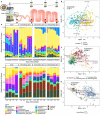Short-term supplementation with ω-3 polyunsaturated fatty acids modulates primarily mucolytic species from the gut luminal mucin niche in a human fermentation system
- PMID: 36109831
- PMCID: PMC9481098
- DOI: 10.1080/19490976.2022.2120344
Short-term supplementation with ω-3 polyunsaturated fatty acids modulates primarily mucolytic species from the gut luminal mucin niche in a human fermentation system
Abstract
Consumption of omega-3 polyunsaturated fatty acids (ω-3 PUFAs) eicosapentaenoic acid (EPA) and docosahexaenoic acid (DHA) provides multifaceted health benefits. Recent studies suggest that ω-3 PUFAs modulate the gut microbiota by enhancing health-promoting bacteria, such as the mucin specialist Akkermansia muciniphila. However, these prebiotic properties have been poorly investigated and direct effects on the gut microbiome have never been explored dynamically across gut regions and niches (lumen vs. mucus-associated microbiota). Thus, we studied the effects of 1 week EPA- and DHA-enriched ω-3 fish-oil supplementation on the composition and functionality of the human microbiome in a Mucosal Simulator of the Human Intestinal Microbial Ecosystem (M-SHIME®). Gut microbial communities derived from one individual harvested in two different seasons were tested in duplicate. Luminal and outer mucus-associated microbiota of the ileum, ascending, transverse and descending colons were cultivated over 28 d from fecal inoculates and supplemented with ω-3 PUFAs for the last 7 d. We show that ω-3 PUFA supplementation modulates the microbiota in a gut region- and niche-dependent fashion. The outer mucus-associated microbiota displayed a higher resilience than the luminal mucin habitat to ω-3 PUFAs, with a remarkable blooming of Akkermansia muciniphila in opposition to a decrease of Firmicutes-mucolytic bacteria. The ω-3 PUFAs also induced a gradual and significant depletion of non-mucolytic Clostridia members in luminal habitats. Finally, increased concentrations of the short chain fatty acids (SCFA) propionate in colon regions at the end of the supplementation was associated positively with the bloom of Akkermansia muciniphila and members of the Desulfovibrionia class.
Keywords: Akkermansia muciniphila; DHA; EPA; M-SHIME® fermentation system; SCFA; fish oil; gut microbiota; mucolytic bacteria; prebiotics; Ω-3 PUFAs.
Conflict of interest statement
No potential conflicts of interest were disclosed.
Figures







References
-
- Saini RK, Prasad P, Sreedhar RV, Akhilender Naidu K, Shang X, Keum Y-S. Omega−3 polyunsaturated fatty acids (pufas): emerging plant and microbial sources, oxidative stability, bioavailability, and health benefits—a review. Antioxidants. 2021;10(10):1627. doi: 10.3390/antiox10101627. - DOI - PMC - PubMed
-
- Borsini A, Nicolaou A, Camacho-Muñoz D, Kendall AC, Di Benedetto MG, Giacobbe J, Su K-P, Pariante CM. Omega-3 polyunsaturated fatty acids protect against inflammation through production of LOX and CYP450 lipid mediators: relevance for major depression and for human hippocampal neurogenesis. Mol Psychiatry. 2021;26(11):6773–20. 10.1038/s41380-021-01160-8 - DOI - PMC - PubMed
Publication types
MeSH terms
Substances
Supplementary concepts
LinkOut - more resources
Full Text Sources
Research Materials
